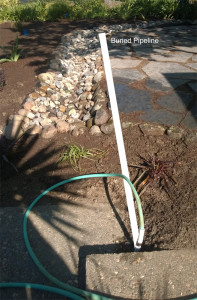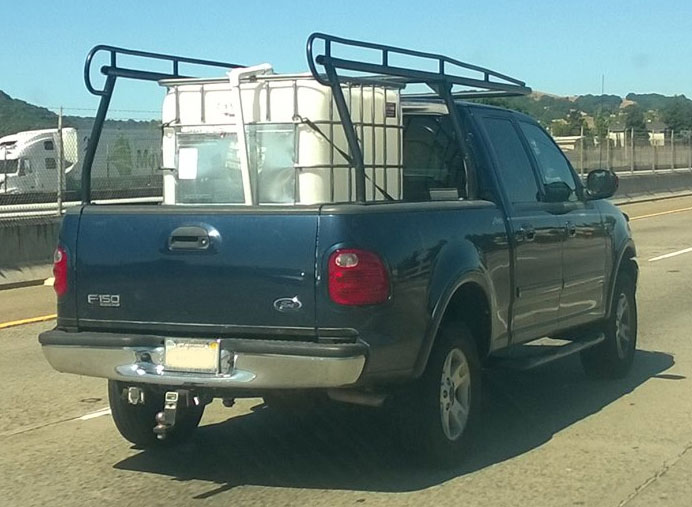Thinking of re-landscaping? Consider including a Swale in your design.
Wait! What is a swale?
As defined by Wikipedia – Swales “are designed to slow and capture runoff by spreading it horizontally across the landscape (along an elevation contour line), facilitating runoff infiltration into the soil.”
So why should I do this?
Swales appear as dry river beds on the landscape but have a buried pipe that serves as a dual purpose. We built ours as a 2′ divider between a patio and a planting area, but it could be utilized anyway you want. We have plumbed one of the downspouts from the roof gutter to our swale, so that when it rains, water from our roof is directed into the ground instead of down the street. This helps to bring the water back into to our soil and provides the water and nutrients to the roots of our plants. Of course, this would require rain.

Dry swale drawing. Source: Stormwatercenter.net
Mine is dug 2′ deep, 2′ wide and is about 25′ long. I have buried 25′ of 3″ black drainage pipe (10′ of solid pipe and 15′ of perforated pipe). The piping is perforated to allow water to infiltrate into the ground.
As shown how to bury a drainage pipe online, the pipe is surrounded by gravel – found at any masonry supply yard, and then landscape fabric is between the gravel and the ground. On top of the swale, at ground level, the rock has been shaped like a dry river bed, more landscape fabric was laid down and river rock as placed as well.
How does recycled water play a role?
Remember how I buried that perforated drainage pipe? Well, I also plumbed in a dedicated recycled water pipe from the walkway to the middle of the swale.

A 1/2″ PVC pipe is buried underground to allow for recycled water to be directed into the Swale, lessening the need to hand water the yard.
This pipeline is 1/2″ PVC with a female hose connection on one end, a T-fitting on the other to allow water to flow into the swale. The outlet is hidden by rocks.
When I unload recycled water into this pipeline, the water percolates into the ground and uses the buried drainage pipe as temporary storage until the ground is ready to absorb more water. If too much water is unloaded here, the water will pool on the surface of the swale for about 10-15 minutes before the ground absorbs it below rock level.
A few days after unloading, the ground is still moist in area’s near to the swale.
By keeping the ground wetter than normal, I am just using this as an avenue of replenishing water that would otherwise be normally deposited from sprinklers.



so it’s basically a french drain? if not, how does it differ?
Very similar, good catch. French drains while built the same way work to drain the property and flow the water away. The swale was built to capture the water and let it percolate into the ground.
ok, so if i have a (large) property and my goal is to pipe water away from specific area, i should build a french drain….but i live in a residential neighborhood on approx 3/4 of an acre and have a natural swale between my house and my (lovely) neighbour’s house. after a rainstorm, i notice water collects along this property barrier. my neighbor couldn’t care less, but i do. i piped a sprinkler system in last year and have just begun the finishing touches. while digging the trenches (with shovel, no trencher lol) i constantly kept hitting rocks so i’d pick them up and toss them to the side. now i have two situations: a swamp on the property line and a ridiculous amount of rocks. i haven’t trenched the front yard for pipe yet, but the proposed location for the sprinkler system’s pvc would be directly below the swamp/property line so, my question is, should i kill two birds with one stone and back fill the trench with rock? would i have to lay 4″ corrugated, like you did, beforehand? what if i did not lay any pipe and only backfilled with rocks? i’m not worried about crushing the sprinkler pipe because it’s schedule 40 pvc. i do know one thing, i’d get ride of a lot of rock that i have no desire to haul off. i just don’t know if i would encourage water to better infiltrate the ground. a few inches of top soil would have to be added so as to be able to seed. here in missouri, right next to the mississippi river, the ground is like concrete and the clay content is way above average.
thanks in advance for your opinion
thanks for the ideas! much appreciated
I think I will use swales in my next landscaping project. Thank you for this excellent recommendation. Also, I will follow your advice on how to use swales correctly for landscaping.